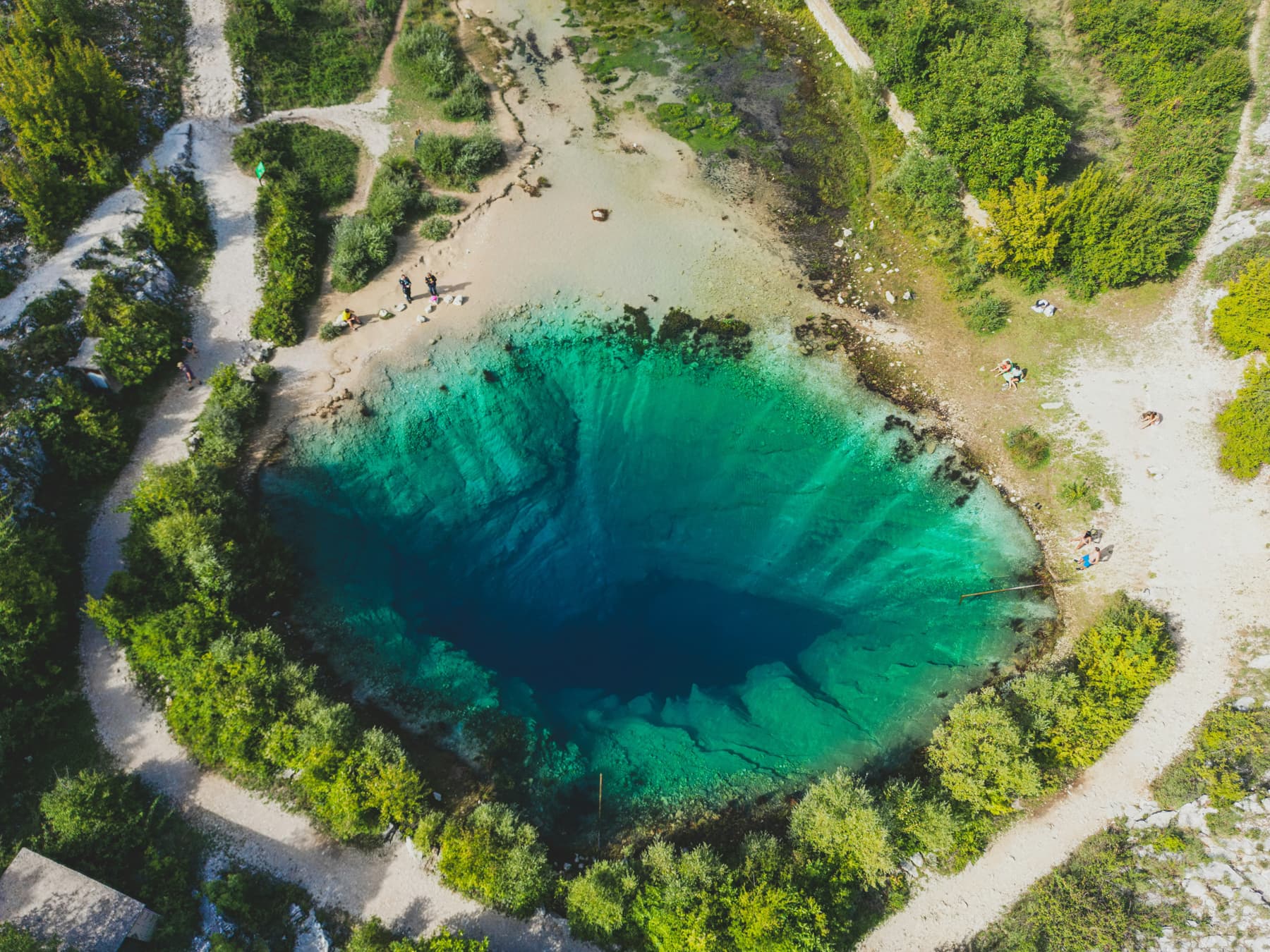
Go World Travel is reader-supported and may earn a commission from purchases made through links in this piece.
Did you know that Croatia has a natural wonder called the Eye of the Earth? This epic source of the Cetina River earned its nickname because it truly resembles a stunning blue eye.
However, this is not Croatia’s only unusually shaped natural wonder. Croatia has islands shaped like fish (Gaz Island) and fingerprints (Baljenac Island). There is even the heart-shaped island of Galešnjak, which became extremely popular after Google Earth highlighted it as one of the rare natural heart-shaped phenomena. Also, after Beyonce celebrated her 39th birthday there.
Planning a last-minute trip to Croatia?
Top Experiences and Tours in Croatia:
- See the sights with a tour of Montenegro Full-Day Trip from Dubrovnik
- See nature with Plitvice Lakes and Rastoke, Small Group Tour from Zagreb
- Explore more with From Hvar: Vis Island and Blue Cave Speedboat Tour
Where to stay in Croatia:
- Find accommodation with Booking.com
- Get a rail pass through Rail Europe
- Find Bus, Train, and Flight tickets with one search through Omio
But let’s go back to the Eye of the Earth.
This hidden gem is one of the most unique attractions in Europe, and it usually reminds people of cenotes in North and Central America. It is in southern Croatia, near Highway 1, in the village of Cetina, near the Bosnia and Herzegovina border. It is the ideal peaceful day trip while visiting the Dalmatia region and its well-known locations like Split, Hvar, Zadar, Šibenik, and Dubrovnik.
So, before you go, here’s a travel guide with everything you need to know.
The Eye of the Earth: The Source of the Cetina River (Izvor Cetine)
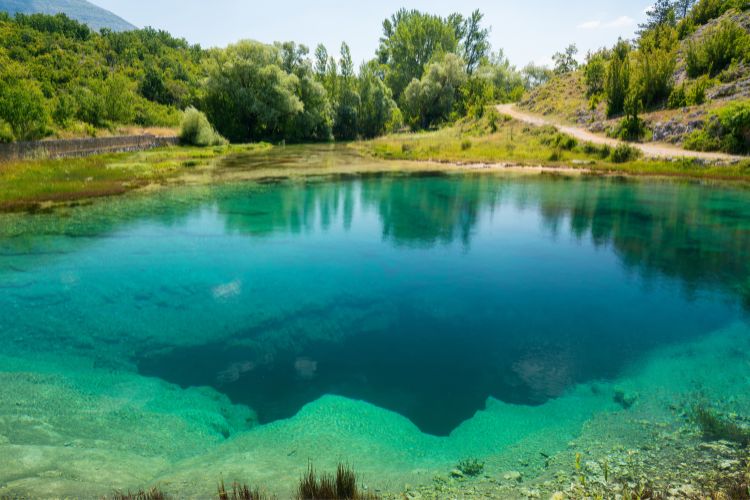
In Dalmatian Zagora, 7 kilometers from Vrlika. The Eye of the Earth is 385 meters above sea level.
The vibrant blue and green colors of the Cetina River Spring water provide an ideal contrast to the foothills of the Dinara Mountain range.
This epic spring is a karst spring—the point of concentrated groundwater discharge from conduits in bedrock.
The Cetina River Spring marks the start of the 100-kilometer journey of the longest Dalmatian river, which flows through valleys, fields, gorges and canyons before joining the Adriatic Sea in town of Omiš.
Nature lovers will appreciate Cetina’s epic waterfalls in Zadvarje, while rafting and adrenaline junkies will be enthralled with the fast-moving water.
The Eye of the Earth, also known as Glavaševo Vrilo or Veliko Vrilo, is the largest of Cetina’s springs. It was recognized as a natural hydrological monument in 1972.
But how deep is it? Will you be able to swim in it? What is the temperature? What else should you do and how will you get that stunning picture?
The Mystery of the Cetina River Spring
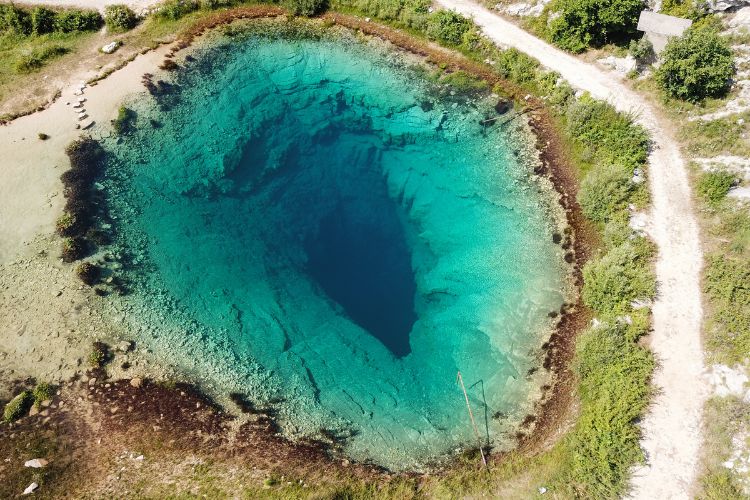
How deep is the Eye of the Earth? Nobody knows.
The crystal-clear water makes it appear shallower than it is, but a closer look reveals a depth that is far from safe.
Despite its small size (less than 30 hectares), the Eye of the Earth mysteriously keeps its secrets hidden from everyone. It is still partially unexplored and although divers have reached depths of 120 meters they haven’t hit rock bottom.
Would you be brave enough to swim there? If you answered yes, I must disappoint you. Why? Keep reading.
No Ice Bath, Please
In the past two to three years, swimming in the heart (or pupil) of the Eye of the Earth has become increasingly popular among tourists worldwide.
But another important piece of information went unnoticed: this incredible karst spring is the source of the drinking water used by the waterworks.
So, last year, the village of Cetina banned swimming in the Eye of the Earth due to local activism.
However, if you do not like ice baths, you would probably avoid bathing in this cold water anyway, because it is around 8 degrees Celsius.
Croatian and Dalmatian History
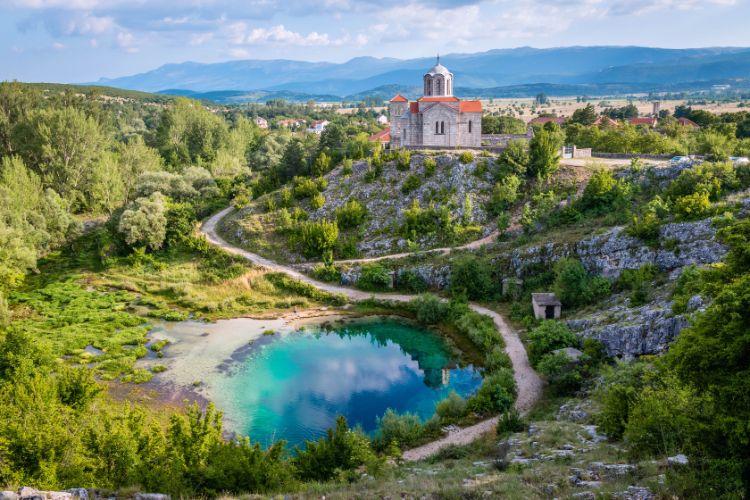
The Eye of the Earth is surrounded by the foothills of the Dinara Mountain Range and several historical sites.
There is the Church of Holy Salvation, the oldest church in Croatia, which was constructed in the 9th century. It is surrounded by a medieval cemetery that dates back to the fourteenth and fifteenth centuries.
When you look into the crystal-clear water of the spring, you will notice the reflection of the other historical site: the Orthodox Church, which adds to the already breathtaking scenery.
Also, a small digression: some refer to the Eye of the Earth as the Dragon’s Eye. However, Croatia already has an attraction called the Dragon’s Eye, which is associated with another natural beauty: the lake in Rogoznica.
The Best View of The Eye of the Earth
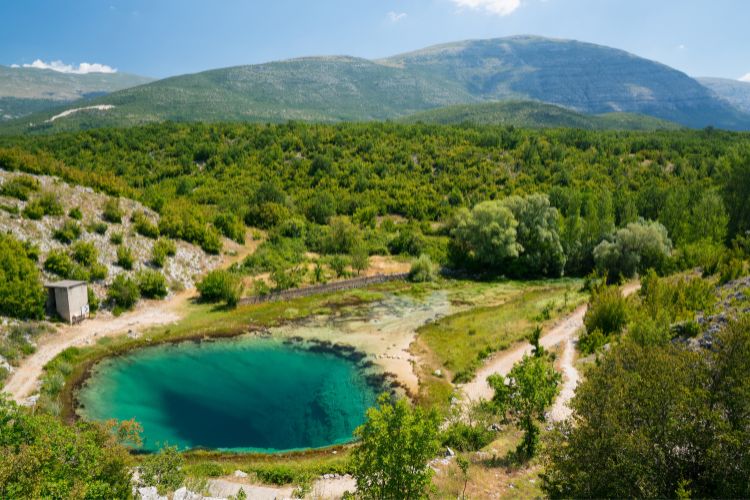
It much more difficult to take a bad picture than a good one here. Especially when viewed from above, which is the best way to see how much this spring truly looks like an eye.
A nearby viewpoint (with free parking) offers a bird’s-eye view, but, to be honest, it isn’t as high as it should be for this location.
That is why locals will tell you to climb the nearby hill. Of course, you obviously don’t need locals for that since you have me.
Best Time to Visit the Cetina River Spring
And now, shocking news: if you want to avoid crowds, come during the off-season. However, even though this natural wonder has grown in popularity in recent years, it is still not nearly as popular as it could be. So even in high season, you can enjoy the peace this beautiful place provides.
The majority of visitors arrive between 10 a.m. and 4 p.m., and for good reason: if you want to see the color shades that perfectly capture the depth of this karst spring, come around noon. Note also that there are no tourist attractions, restaurants or coffee shops here so bring your own refreshments.
How Do You Get to the Source of the Cetina River?
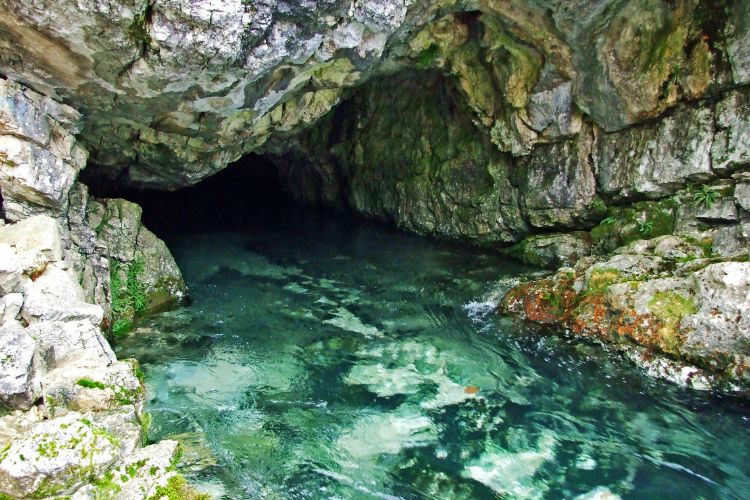
Izvor Cetine does not have public transportation, which is a good thing because it keeps the area less crowded. You can get there by joining one of the organized tours. But the best way is by car and Google Maps will direct you perfectly. Plus, hiring a car is the best way to discover Croatia in general.
That way, you can swim in the Adriatic Sea one day and hike the next. You can then visit one of the national parks the third day (I recommend Krka waterfalls, or if you want to go further and visit the capital Zagreb, I recommend Plitvice Lakes National Park) and explore the plains the fourth day. On the fifth day breathe in the fresh air of dense forests…anyway, you get my point.
How Much Will It Cost to Visit The Eye of the Earth?
Croatia’s official currency is now the euro (it was previously the kuna).
But, as they say, the best things in life are free. If you drive yourself you can enjoy the breathtaking scenery of this natural wonder for free. You can also park for free in the nearby parking area.
That’s what it means to be a good host, right?
Rafting, Hiking, Ziplining and More
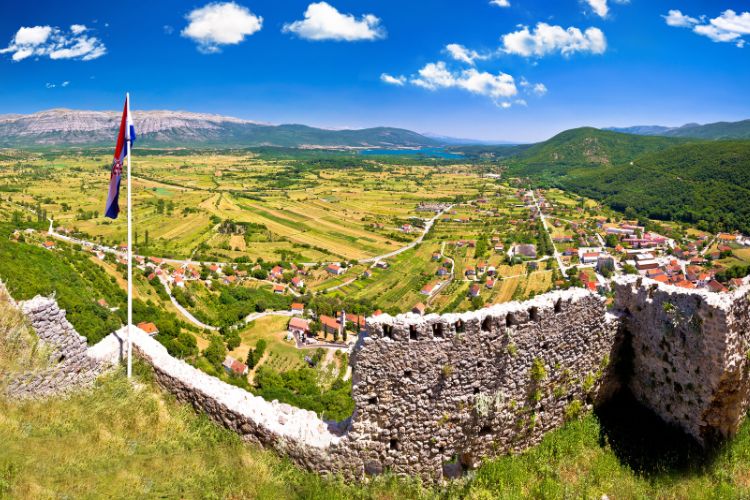
The Cetina River, which is sometimes calm and sometimes unpredictable, never fails to entertain its visitors. So, it’s perfect for canoeing and rafting.
Throughout your unforgettable adventure, you will be surrounded by stunning rocks, cliffs, crystal-clear water and lush Mediterranean vegetation while being guided by knowledgeable skippers.
You can also walk, hike, explore mysterious caves and archaeological sites, swim, run, climb, or enjoy a picnic. But nothing beats taking a zip line and viewing this beautiful place from above. It will undoubtedly be a highlight of your experience.
Alternatively, you can go on a cycling tour starting in Sinj city and take in the beautiful scenery, which includes Peruća Lake. If you have more than one day, which you most likely will, take a day trip to the breathtaking Blue Cave and find out why Greta Garbo was repeating only three words while looking at it: “Oh, my God.”

During your visit to Dalmatian Zagora, you must try Drniški Pršut, as the hosts will tell you that only prosciutto dried on the wind of Drniš is real prosciutto. As a Slavonian, I’ll say that Slavonian prosciutto dried in the Slavonian wind is at least as tasty. (Note: Slovenia is a country; Slavonia is a region within Croatia.)
Also while in Dalmatia, try homemade Dalmatian sheep’s cheese, Imotski cake and arambaš. To eat like the locals, choose places that combine tradition and produce food themselves, such as the Campanelo family tavern.
And that’s about all you need to know before you visit the source of the Cetina River, a hidden gem that you’ll surely remember for a long time.
Read More:
- 15 Things You Didn’t Know About Croatia - April 3, 2024
- Top Things to See and Do in Malta - April 1, 2024
- Croatia’s Natural Wonders: The Top 13 Beautiful Waterfalls You Must See - March 27, 2024

